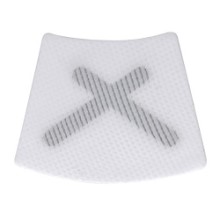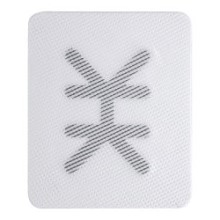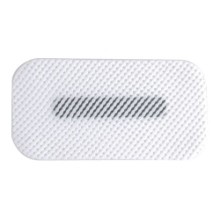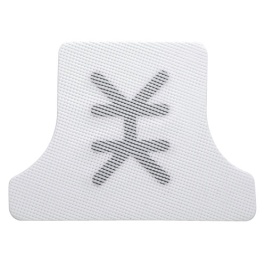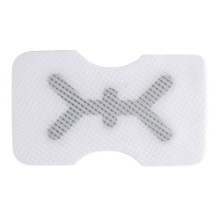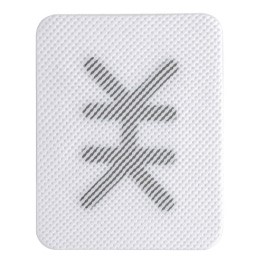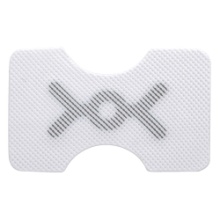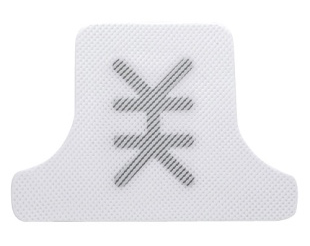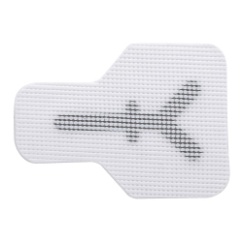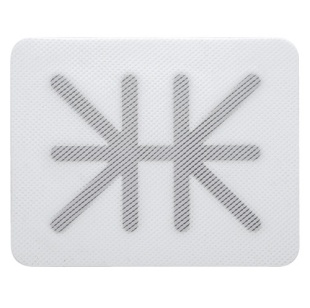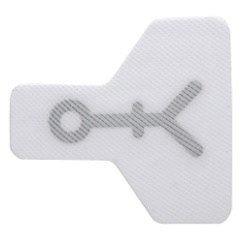오스코 비흡수성 차폐막
www.ossco.kr
SMOOTH CYTOFLEX® Tef-Guard®

Cytoflex Smooth Tefguard is a non-resorbable, space-making, barrier membrane intended for guided tissue regeneration procedures. Composed of proprietary micro-porous polytetrafluoethylene (ePTFE) thin film, Cytoflex smooth Tefguard has a surface texture and porosity suitable for host cells to attach upon. The micro porous surface is designed to prevent bacteria from penetrating through the membrane while promoting diffusion of interstitial fluid for optimal healing. It also allows for improved adhesion between gingiva tissue and the membrane, preventing passage and integration of bacteria within the interstices of the material.
The supple membrane conforms easily to tissue contours and offers sufficient rigidity to maintain space over the bony defect. The smooth version has micro pore texture on both surfaces. The cellular micro texture is invisible to the naked eye but can be seen at high magnifications.
Availability
Each Cytoflex® Tefguard® membrane is provided double pouched and sterile.
| Cat. ID. | Products | Package |
| C01-0301 | TEFGUARD TEF-001 | 12mm x 24mm, 1 / pk |
| C01-0305 | TEFGUARD TEF-001 | 12mm x 24mm, 5 / pk |
| C01-0101 | TEFGUARD TEF-002 | 25mm x 30mm, 1 / pk |
| C01-0105 | TEFGUARD TEF-002 | 25mm x 30mm, 5 / pk |
Q & A WITH AN EXPERIENCED TEFGUARD® USER
Dr. David Kao, Periodontics and Dental Implants
Fullerton, CA
- How long have you used non-resorbable Cytoflex® Tef-Guard® products? What do you use the products mostly for?
I have used the products since 2011. Mostly I used them for socket grafting with the non-primary closure technique.
- Do you notice any differences between smooth versus textured Cytoflex® Tef-Guard® products?
For the way I use Tef-Guard® in my office, I have not noticed little clinical differences in the smooth and textured. The handling property of the textured membrane is a bit improved over the smooth version. I find that the textured membrane is more durable. This does allow it to withstand the pressures tucking the membrane in below the gingiva. I also find that I can trim it better, but only marginally better. I will continue to use smooth only for its cost savings.
- In your experience, what is the best way to use the product? Do you under-fill the bone graft or fill to the crest level of the bone before applying the membrane? What suturing technique do you use over the membrane? What kind of sutures do you use to close the wound?
In my experience, the best way to use the product is to stabilize the membrane by extending about 3 mm between the bone and the labial and lingual flaps. If the interdental papillae were not elevated, then a suture would not be necessary. If a suture were necessary, I would utilize a mattress suture over the membrane (either cris-cross or parallel). I commonly use a resorbable suture, such as chromic gut. I have tried both under-filling and over-filling. With the over-fill technique, it is common to experience non-integrated bone graft at the crest. I am inclined to say that under-filling works well.
I generally achieve good bone regeneration after 4-5 months of healing with just an allogenic bone graft (FDBA), Tef-Guard® membrane without primary closure in an intact tooth socket or a socket with minimal bone loss.
- How long do you leave the membrane in place?
I try to leave the membrane in place for 4 weeks. After four weeks, you would get a moderately mature connective tissue with a few spicules of bone graft integrated in it. However, all cases end up with fully mature gingiva. After the removal of the membrane, the patient is advised to resume normal activity. No painkiller or dressings are needed.
- What is the best way to remove the membrane? What instruments do you use?
I remove it by first lifting the membrane with a periodontal probe and extract it with cotton forceps.
- Have you experienced any wound dehiscence while using this membrane? If so, what do you think caused the dehiscence? Any thoughts to prevent such complications?
I have not experienced wound dehiscence with the non-primary closure technique. In general, wound dehiscence is caused by injury (either during or after the procedure), poor blood supply, or thin tissue.
- Do you find Cytoflex® Tef-Guard® easy to use?
I do like the ease of use and would recommend Tef-Guard® products for socket grafting without primary closure.
FAQ
- How is this membrane different from Gore-Tex® and Cytoplast® membranes?
Micro porous Cytoflex® Tefguard® was designed to improve upon experiences learned from Gore-Tex® and Cytoplast® membranes. Macro porous Gore-Tex® was the gold standard of barrier membranes for use under primary soft tissue coverage. The macro pores were designed for tissue ingrowths to stabilize tissue/barrier interface. However, membrane removal after bone regeneration is traumatic. The featureless Cytoplast® membrane was designed to block off soft tissue and bacteria ingrowths, allowing the barrier to be used in non-primary coverage conditions. The relatively non-porous nature of the barrier limits nutrient permeation across the membrane. Cytoflex® Tefguard's® proprietary micro pores were designed to allow nutrient permeation and at the same time prevent penetration of soft tissue and bacteria across the membrane. The combination of nutrient diffusion and micro porous texture enhances soft tissue attachment while preventing bacteria penetration across the membrane.
- What about primary soft tissue coverage of the membrane?
Cytoflex® Tefguard® membranes were designed to serve as a barrier to contain the bone graft material and prevent soft tissue and bacteria in-growth. At the discretion of the practitioners, the barriers have been used in primary coverage and non-primary coverage situation when soft tissue coverage is lacking. The membrane was designed to block off bacteria and thus exposure of the membrane does not result in infection and case failure.
- How long can the membrane stay in place?
In general within four to five weeks the membrane will need to be removed. This will allow enough time for the osseous tissue to begin forming and to be able to resist soft tissue from invading the graft site. However, at the discretion of the clinician, primary closure and longer healing times may be considered, if desirable.
- How to remove the membranes?
Under primary coverage condition, Cytoflex® Tefguard® membrane may be easily removed by creating a small incision in its proximity. With forceps, firmly grasp a border of the material and remove it from the tissue. Local anesthesia is normally used for this procedure. In non-primary coverage situation, the membrane may be lifted with a periodontal probe and extracted with a forcep. After membrane removal, re-epithelialization will occur within two to three weeks to complete the healing process. Final bone maturation will take place for six to twelve months from the time of implantation. This time frame should be considered in treatment planning cases involving heavy prosthetic loading of regenerated bone.
- What is the difference between the Smooth and Textured Cytoflex® Tefguard® barrier membranes? What are the benefits of each as opposed to the other?
Both Cytoflex® Tefguard® membranes have micro-texture. The micro texture allows for better soft tissue attachment over the membrane and a better seal around the bone graft area. The Textured Cytoflex membranes also provide a visible macro-texture similar to the configuration of strawberry fields as opposed to the conventional pot-hole design of other barrier products. This strawberry field texture was designed to further enhance soft tissue attachment and minimize dehiscence over the grafting site.
- Can unused portions of the membrane be resterilized?
No, Cytoflex® Tefguard® membranes are designed for a single use only.
- What is the shelf life the Cytoflex® Tefguard® membranes?
Each sterile Cytoflex® Tefguard® barrier is double packed and has 6-year of shelf life from the date of manufacture.
- Have you ever had a confirmed allergic reaction to micro porous Cytoflex® Tefguard® membranes?
Cytoflex® Tefguard® membranes are made of inert and biocompatible PTFE materials. Since it was cleared in 2002, there have not been any reported allergic reactions caused by Cytoflex® Tefguard® PTFE barrier.
- Are there any contraindications?
Cytoflex® Tefguard® membrane is a passive, non-load bearing material and should not be used for load bearing applications. Cytoflex® Tefguard® should not be considered for patients where general oral surgery is not advisable.
- What are the potential complications?
Possible complications associated with any oral surgery include infection, flap slough, perforation, abscess formation, bone loss, pain and complications associated with the use of anesthesia. Depending upon the type and severity of the complication, as judged by the clinician, early material removal may be required.
CYTOFLEX® MESH
 Cytoflex® Mesh is made of a pure, implantable Titanium mesh with precision mesh profile. This product is designed for use to ensure three-dimensional reconstruction of alveolar bone defects and to facilitate bone augmentation through adequate fixation of the augmentation material. The thin, supple mesh conforms easily to tissue contours, and yet presents sufficient stiffness to maintain a space over the bony defect.
Cytoflex® Mesh is made of a pure, implantable Titanium mesh with precision mesh profile. This product is designed for use to ensure three-dimensional reconstruction of alveolar bone defects and to facilitate bone augmentation through adequate fixation of the augmentation material. The thin, supple mesh conforms easily to tissue contours, and yet presents sufficient stiffness to maintain a space over the bony defect.
Availability
Cytoflex® Mesh is available in single quantities. They are provided double pouched and sterile.
| C02-4101 | C02-4201 | C02-4301 | C02-4401 | C02-4501 |
| M4-100 | M4-200 | M4-300 | M4-400 | M4-500 |
12mm x 25mm
 | 12mm x 25mm
 | 20mm x 25mm
 | 25mm x 30mm
 | 30mm x 40mm
 |
Cytoflex Mesh® Clinical Studies
FAQ
- What are the advantages of Cytoflex Mesh?
Cytoflex Mesh was designed for ease of use to securely contain the bone graft material in a 3-dimensional curve. It can be easily trimmed with surgical scissors, draped over the defect contours and prevent spontaneous collapse after primary closure.
- Will Cytoflex Mesh tear during screw fixation?
Cytoflex Mesh is made with pure titanium with a precision mesh profile. It is made with sufficient strength to prevent tear during a normal screw fixation procedure.
- What bone screw sizes are suitable for Cytoflex Mesh?
The most common size screw used with Cytoflex Titanium Mesh is the 4mm size. Really any size from 3mm ¡V 5mm screws will be suitable depending on the clinical situation (i.e. thickness of bone and where the mesh is placed) but the 4mm size is more commonly used.
- What makes the Cytoflex Mesh a golden color?
All Cytoflex Titanium Mesh goes through an anodizing process to strengthen the metal and leaves it with a golden hue.
- Can M4-300 model be fixated with an abutment screw?
The M4-300 model was designed for fixation with an abutment screw. The fixation hole has a diameter of 2.5mm, suitable for fixation with most abutment screws.
TI-ENFORCED™

Ti-Enforced™ ePTFE membranes are a multi-layer, non-resorbable membrane intended to be surgically placed under the muco-periosteum to aid in tissue regeneration in accordance with the guided tissue regeneration principle. It is a barrier material with a titanium frame enclosed within two layers of ePTFE material. The titanium reinforcement is intended for space and shape maintenance to contain bone grafting material and to minimize graft movement during wound healing. The membranes are designed to block bacteria penetration, and impede the migration and establishment of gingival tissue derived cells into bony defects. This provides a more favorable environment for neovascularization and for bone derived cells to repopulate and repair the defect. The Ti-Enforced™ membranes are textured on both surfaces to improve handling and adhesion between tissue and membrane.
FAQ
- What is Ti-Enforced™ membrane made of?
Ti-Enforced™ membrane is composed of a titanium frame enclosed within two layers of expanded polytetrafluoroethylene (ePTFE) material. It is a passive, non-load bearing membrane.
- What is the purpose of enclosing a titanium frame within an ePTFE membrane?
The titanium reinforcement is intended for space and shape maintenance to contain bone grafting material and to minimize graft migration during wound healing. Ti-Enforced™ membranes are designed to reduce the migration and establishment of gingival tissue derived cells into bony defects thus providing a more favorable environment for neovascularization and bone derived cells to repopulate and repair the defect.
- What is the enclosed titanium frame made of?
The titanium frame is made of pure, implantable grade titanium.
- What are the indications of Ti-Enforced™ membrane?
Ti-Enforced™ membrane is cleared for use as a space-making barrier in the treatment of periodontal defects and augmentation of alveolar ridge in accordance with guided tissue regeneration principle. It is a temporarily, non-resorbable, implantable material.
- How long is Ti-Enforced™ membrane implanted for?
The membrane is intended to be submerged and implanted for more than 30 days and up to 6 months.
- Are Ti-Enforced™ membranes textured on both sides?
All Ti-Enforced™ membranes have micro and macro texture on both surfaces.
- What are the Advantages of Texturing on Both Surfaces?
By having both surfaces of Ti-Enforced™ textured, doctors do not have to be concerned about which side should face up toward the gingival tissue or face down toward the bone graft material. This makes it easier for doctors to use the membrane.
The unique strawberry field texture pattern provides more surface area for the gingival tissue to adhere to the membrane, and to stabilize the wound site. The texture surface facing the bone graft material prevents the membrane from sliding around the graft material, making it easier to position the membrane over the graft material.
- May Ti-Enforced™ be trimmed and shaped to fit a variety of defect sizes?
The membrane may be cut to the desired configuration with scissors. After trimming, there should be no sharp corners or rough edges. To enhance stability and adequate protection of the space over the bony defect, the membrane should be trimmed to extend 3mm beyond the defect margins and to remain at least 1mm from adjacent, uninvolved teeth. The membrane may be curved to create a dome shape, if desired, for containing the graft.
CAUTION: Excessive bending of the titanium frame or trimming of the membrane close to the titanium frame may cause the membrane to delaminate. If the membrane delaminates or if the titanium frame perforates through the ePTFE material, it should not be used. The membrane should be handled using only powder free gloves and/or with sterile atraumatic forceps.
- May screws or tacks be used to stabilize Ti-Enforced™ membranes?
Ti-Enforced™ membranes can be stabilized with surgical tacks or screws.
- What are the recommended closure techniques?
In general, a double layer closure, with a deep layer of horizontal mattress suture followed by a standard wound closure with interrupted suture is recommended. During primary closure, adequate flap release must be accomplished in order to achieve a tension-free closure. The use of long lasting monofilament suture is recommended to prevent premature loss of suture strength, which may lead to early membrane exposure during the initial 2-week healing period.
- How should the membrane be removed?
When removal is desired and the membrane is exposed, the membrane may be removed, by grasping with a forcep and gently remove it from the tissue. Local anesthesia may be provided to enhance patient comfort, but is not necessary. If primary closure is obtained at placement, surgical exposure may be required for removal. Re-epithelialization will occur within 2 to 3 weeks to complete the healing process. After membrane removal, final bone maturation will take place for 6 to 12 months from the time of implantation. This time frame should be considered in treatment planning cases involving prosthetic loading of regenerated bone.
- Can unused portions of Ti-Enforced™ membrane be re-sterilized and re-used?
No, Ti-Enforced® membranes are designed for single use only.
- What is the shelf life of Ti- Enforced™ membranes?
Ti-Enforced™ membranes are double packed and have a 4-year shelf life from date of manufacture.
- Have you ever confirmed an allergic reaction to Ti-Enforced™ membranes?
There has been no reported allergic reaction caused by Ti-Enforced® membrane. It is made of inert, biocompatible ePTFE material.
- Are there any contraindications?
Ti-Enforced™ membranes are not designed for use under load bearing conditions.
- What are the potential complications?
Possible complications associated with any oral surgery include infection, flap slough, perforation, abscess formation, bone loss, pain and complications associated with the use of anesthesia. Depending upon the type and severity of the complication, as judged by the clinician, early material removal may be required.
AVAILABILITY
Ti-Enforced™ ePTFE membranes are provided double pouched and sterile.

 Cytoflex® Mesh is made of a pure, implantable Titanium mesh with precision mesh profile. This product is designed for use to ensure three-dimensional reconstruction of alveolar bone defects and to facilitate bone augmentation through adequate fixation of the augmentation material. The thin, supple mesh conforms easily to tissue contours, and yet presents sufficient stiffness to maintain a space over the bony defect.
Cytoflex® Mesh is made of a pure, implantable Titanium mesh with precision mesh profile. This product is designed for use to ensure three-dimensional reconstruction of alveolar bone defects and to facilitate bone augmentation through adequate fixation of the augmentation material. The thin, supple mesh conforms easily to tissue contours, and yet presents sufficient stiffness to maintain a space over the bony defect. 





